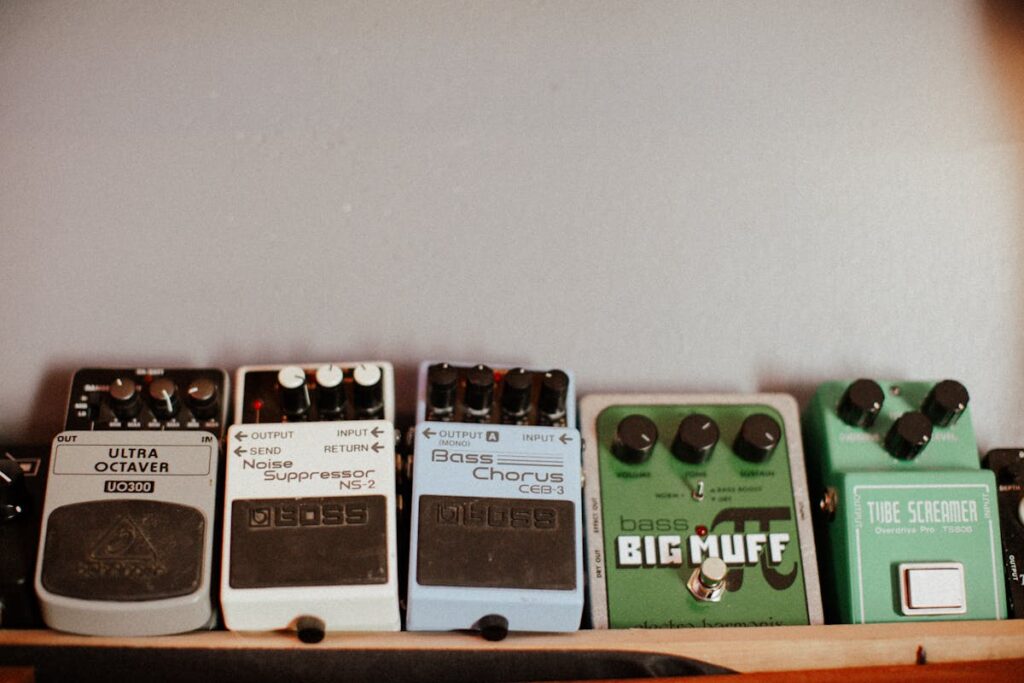If you are into the guitar world, you may have heard about the Big Muff. This mythological Fuzz pedal has shaped the sound of rock, grunge, stoner, and doom for decades. While the original U.S.-made electro-harmonics versions are distinguished, the Russian large Muff model was carved after its own creed. Manufactured during the post-Soviet era, these paddles look rugged, make different sounds, and have become equally highly demanded by musicians and collectors. But how do different versions of Russian Big Muff actually compare? Let’s break it.
History of Big Muff
The Big Muff first appeared in the late 1960s, designed by Mike Matthews of Electro-Harmonics. It is quickly known for its thick, violin-like, constant, and aggressive fades. Players like David Gilmar, Jimmy Hendrix, and later Kurt Cobain strengthened their place in music history. When the electro-harmonics closed in the early 1980s, the production moved, which led to the manufacture of Russian-made versions via Sovtech in the 1990s. These Russians provide a slightly different character in themselves than their American cousins.
The Green Russian Big Muff
Russian Big Muff stands out for its rugged enclosures, unique circuit variations, and deep, heavy sound. Compared to American models, they often have low treble cutting and more low-end punch, making them perfect for heavy refers and doom-laden chords. Manufactured in strong metal cases, these paddles were designed to face the chaos of the seizures of musicians – and sometimes looked like military surplus gear.
Black Russian Bada Muff
Black Russian chased Green, with a smooth black and yellow design. While it shared several tanwala properties with green, some players saw a slightly lower end and slightly more midrange appearance. It became popular as it was inexpensive and widely available during the late 90s, making musicians easy to access that prestigious Faz Sound.
Civil War Big Muff (Blue and Gray)
Before green and black, the Civil War was Big Muff, named for its blue and gray paint scheme. The version later offered smooth gains and more balanced EQ than the Russian paddle. Many players consider it one of the most versatile Russian Muffs, which are capable of crushing both and crushing the leading leads. Its relationship with a grunge band like Nirvana combines its mythological status.
Long font green Russian big muff
Collectors often go crazy on long font green versions. Recognized by its long font lettering on the enclosure, this model is known for a slightly more open and raw sound than the later green Russians. Fans of Stoner Rock and Doom often quoted it as the last Russian muff to crush the low-end faz.
Bubble Font Green Russian Big Muff
The bubble font version later came and showed more goal letters on the attachment. While similar to other green versions, players sometimes describe it as a little smoother and less raw. For many people, differences are subtle, but collectors and fusing enthusiasts still argue over who saves the “Trust” Russian sound.
Comparison of Russian vs American big muff
American large muff usually maintains more triple and maintains, forming a sharper, cutting tone that works well for solos and lead. On the other hand, Russians emphasize Muff, Summer, and Bass, making them better for rhythmic music. Think of it in this way: a USA razor blade is sliced through the Muff mixture, while a sledgehammer is smashing through the Russian muff walls.
Russian Bada Muff and Granj Music
When there was an explosion in grunge in the 1990s, Russian Big Muff was there. Bands such as Nirvana, Mudhony, and Smashing Pumpkins leaned to their wall-to-dhwani fazy to define an era. Its deep, heavy vowel fully strengthened its reputation as a pedal for alternative rockers, adapted to the raw energy of the grunge.
Russian big muff in modern styles
Even today, Russian Big Muffs find a home in doom, mud, stoner rock, and shoegaze. Bands such as Electric Wizards and Sleep use it to achieve large-scale, earth-hailing fuzz tones. Shoegaze players love their ability to make a thick soundscape that completely swallows the listener. Despite being decades old, it is one of the most versatile fazal paddles in heavy music.
Build quality in versions.
One of the defined characteristics of the Russian Big Muff is its tank-like construction. The enclosures are heavy, the switches are rugged, and the overall experience is industrial. Of course, it also meant that there were discrepancies – some paddles were given a slightly different way, which led to small tanwala differences. Nevertheless, most players agree that they are almost indestructible compared to their American counterparts.
Reissues and Modern Clone
Because the original Russians have grown rare and expensive, Electro-Harmonix released the green Russian re-pasyu, a small, pedalboard-friendly version. While not the same, it catches the low-end heat and smooth fades of the origin too much. At the top of it, many boutique builders now create clones and variations inspired by Civil War and green models, leading to cheap access to those mythological tons.
Which version should you choose?
If you are a collector, the long font green or Civil War version is the holy grail. If you are just chasing a player, green Russian or Black Russian will distribute the crushed faze without breaking the bank. And if you want modern credibility, green dandruff is a solid option again. Finally, the “best” Russian Big Muff depends on the fact that you give importance to history, tone, or practicality.
Conclusion
Russian Big Muff is more than just a fuzz pedal – this is a piece of music history. From grunge to doom, it has shaped the sound of countless bands and continues to inspire players today. Each version, whether civil war, green, or black, his signature bears his sonic fingerprint when sharing a hot, heavy faze. Whether you are hunting a collector hunting rare paddle, or a musician who wants to highlight the rifts on a large scale, there is a dandruff for you.





